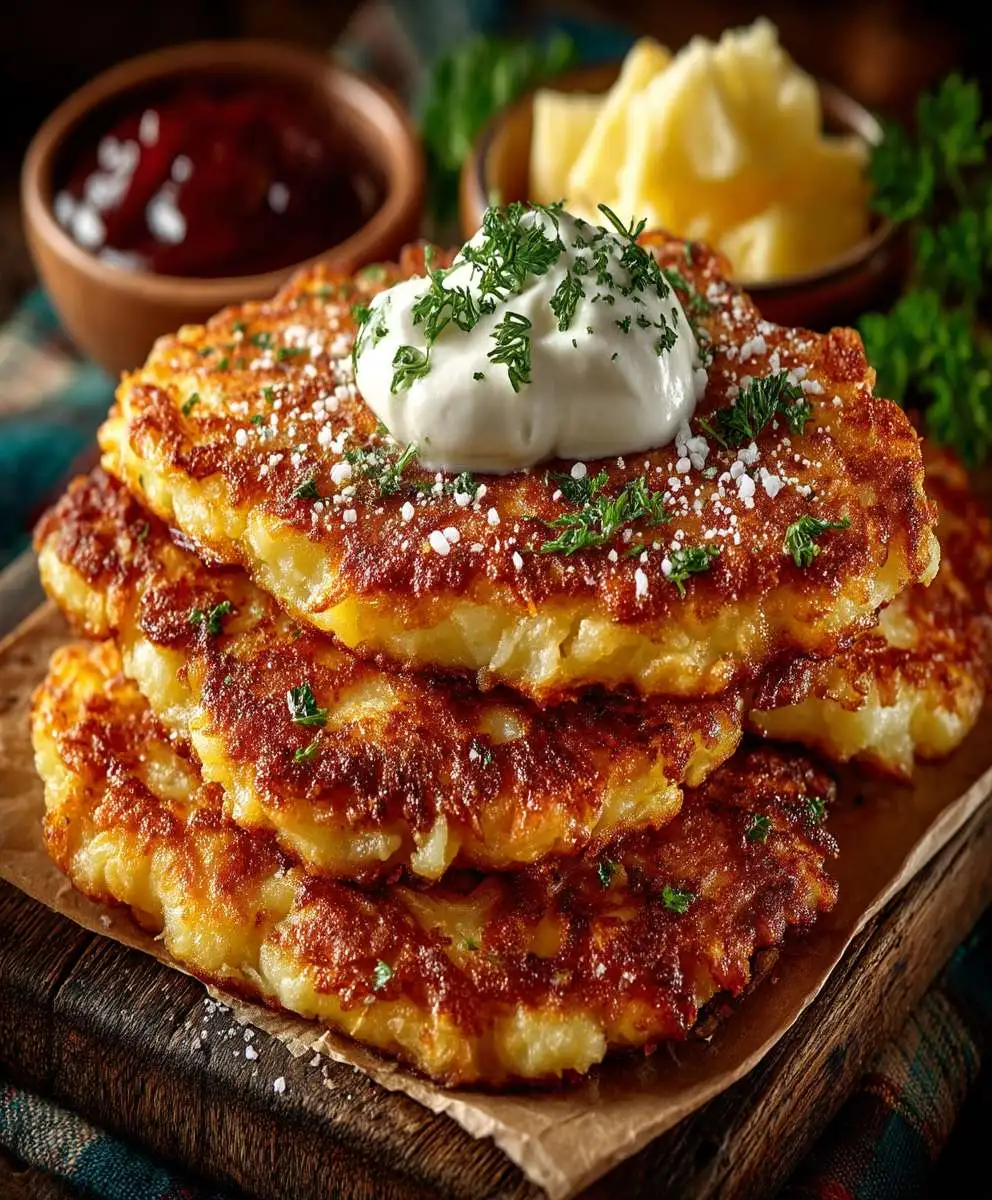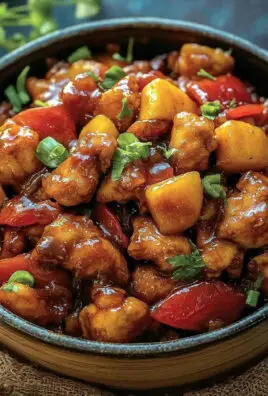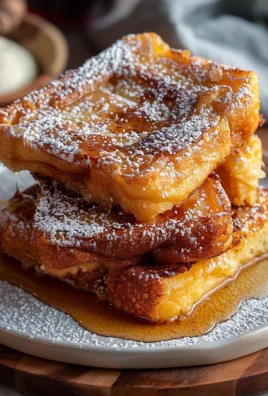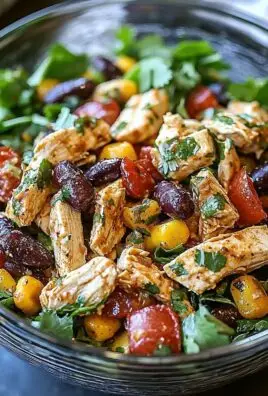German Potato Pancakes, or “Kartoffelpuffer” as they’re lovingly known in Germany, are a culinary hug on a plate. Imagine biting into a crispy, golden-brown pancake, the savory aroma of fried potatoes filling the air. But these aren’t just any potato pancakes; they’re a taste of tradition, a comforting reminder of family gatherings and festive celebrations.
These humble pancakes have a history as rich as their flavor. Rooted in centuries-old European peasant cuisine, German Potato Pancakes were a resourceful way to use readily available potatoes, transforming them into a satisfying and nourishing meal. They’ve become a staple at Christmas markets and Oktoberfests, their irresistible scent drawing crowds from near and far.
What makes these pancakes so beloved? It’s the delightful contrast of textures – the crispy exterior giving way to a soft, slightly sweet interior. The simple yet satisfying flavor profile, enhanced by a dollop of applesauce or a spoonful of sour cream, is pure comfort food. Plus, they’re surprisingly easy to make, making them a perfect weeknight dinner or a fun weekend project. So, let’s dive into this classic recipe and bring a little bit of German warmth to your kitchen!
Ingredients:
- Potatoes: 2 lbs, Russet or Yukon Gold, peeled
- Onion: 1 medium, finely grated or minced
- Eggs: 2 large
- All-Purpose Flour: ½ cup, plus more for dusting
- Baking Powder: ½ teaspoon
- Salt: 1 ½ teaspoons, or to taste
- Black Pepper: ¼ teaspoon, or to taste
- Nutmeg: Pinch (optional, but highly recommended!)
- Vegetable Oil or Lard: For frying
- Applesauce or Sour Cream: For serving (optional)
Preparing the Potato Mixture:
- Grate the Potatoes: This is the most important step! You have a couple of options here. You can use a box grater with large holes, or you can use a food processor with a grating attachment. If using a box grater, be careful of your fingers! If using a food processor, work in batches to avoid overcrowding. The goal is to get coarsely grated potatoes.
- Drain the Potatoes: Once the potatoes are grated, you need to remove as much excess moisture as possible. This is crucial for getting crispy pancakes. Place the grated potatoes in a clean kitchen towel or cheesecloth. Gather the edges of the towel and squeeze firmly to extract the liquid. You’ll be surprised how much water comes out! Repeat this process a couple of times to ensure you’ve removed most of the moisture. Alternatively, you can place the grated potatoes in a colander and press down firmly with a spoon to extract the liquid.
- Combine Ingredients: In a large bowl, combine the drained grated potatoes, grated onion, eggs, flour, baking powder, salt, pepper, and nutmeg (if using). Mix well until everything is evenly distributed. Don’t overmix, as this can develop the gluten in the flour and make the pancakes tough. The mixture should be slightly wet but not watery. If it seems too wet, add a tablespoon of flour at a time until you reach the desired consistency.
Frying the Potato Pancakes:
- Heat the Oil: Place a large skillet (cast iron is ideal!) over medium-high heat. Add enough vegetable oil or lard to coat the bottom of the skillet, about ¼ inch deep. The oil should be hot enough that a small piece of potato mixture sizzles immediately when dropped in. If the oil isn’t hot enough, the pancakes will absorb too much oil and become greasy. If it’s too hot, they’ll burn on the outside before they’re cooked through on the inside.
- Form the Pancakes: For each pancake, scoop about ¼ cup of the potato mixture into the hot oil. Gently flatten the mixture with the back of a spoon to form a pancake about ½ inch thick. Be careful not to overcrowd the skillet; cook in batches to avoid lowering the oil temperature too much.
- Fry the Pancakes: Fry the pancakes for about 3-4 minutes per side, or until they are golden brown and crispy. Use a spatula to carefully flip the pancakes. If they are browning too quickly, reduce the heat slightly.
- Drain the Pancakes: Once the pancakes are cooked through, remove them from the skillet and place them on a wire rack lined with paper towels to drain excess oil. This will help them stay crispy.
Serving and Enjoying:
- Serve Immediately: German potato pancakes are best served hot and fresh. They tend to lose their crispness as they sit, so try to serve them as soon as they’re cooked.
- Choose Your Toppings: The classic accompaniments for German potato pancakes are applesauce and sour cream. I personally love both! The sweetness of the applesauce complements the savory flavor of the pancakes perfectly, while the sour cream adds a creamy tang. You can also try other toppings, such as:
- Chives: Freshly chopped chives add a nice herbaceous flavor.
- Bacon: Crispy crumbled bacon is always a welcome addition.
- Onion Dip: A creamy onion dip is another great option.
- Gravy: For a heartier meal, try serving the pancakes with gravy.
- Enjoy! Now, sit back, relax, and enjoy your delicious homemade German potato pancakes! They’re perfect for breakfast, lunch, or dinner.
Tips and Tricks for Perfect Potato Pancakes:
- Potato Choice Matters: While you can use any type of potato, Russet or Yukon Gold potatoes are generally preferred for potato pancakes. Russets have a higher starch content, which helps them bind together better and get crispier. Yukon Golds have a slightly creamier texture and a more subtle flavor.
- Don’t Skip the Draining Step: I can’t stress this enough! Removing excess moisture from the grated potatoes is absolutely essential for getting crispy pancakes. If you skip this step, your pancakes will be soggy and greasy.
- Grate the Onion Finely: Grating the onion finely ensures that it cooks evenly and doesn’t overpower the flavor of the pancakes. You can also use a food processor to mince the onion.
- Adjust the Flour as Needed: The amount of flour you need may vary depending on the moisture content of your potatoes. Start with ½ cup and add more, a tablespoon at a time, until you reach the desired consistency. The mixture should be slightly wet but not watery.
- Don’t Overcrowd the Skillet: Cooking the pancakes in batches prevents the oil temperature from dropping too much, which can result in greasy pancakes.
- Keep the Pancakes Warm: If you’re making a large batch of pancakes, you can keep them warm in a preheated oven (200°F) while you finish cooking the rest. Place the cooked pancakes on a wire rack in a single layer to prevent them from getting soggy.
- Experiment with Flavors: Feel free to experiment with different flavors and seasonings. You can add garlic powder, onion powder, paprika, or other spices to the potato mixture. You can also add chopped herbs, such as parsley or chives.
- Make Ahead: You can prepare the potato mixture ahead of time and store it in the refrigerator for up to 24 hours. However, keep in mind that the potatoes may release more moisture as they sit, so you may need to drain them again before frying.
- Freezing: Cooked potato pancakes can be frozen for later use. Let them cool completely, then place them in a single layer on a baking sheet and freeze for about 30 minutes. Once they’re frozen solid, transfer them to a freezer bag or container. To reheat, bake them in a preheated oven (350°F) for about 10-15 minutes, or until heated through and crispy.
Troubleshooting:
- Pancakes are too soggy: This is usually caused by not draining the potatoes properly. Make sure to squeeze out as much moisture as possible before mixing the ingredients. You may also need to add more flour to the mixture.
- Pancakes are burning on the outside but not cooked through on the inside: The oil is too hot. Reduce the heat to medium and cook the pancakes for a longer period of time.
- Pancakes are falling apart: The mixture is too wet. Add more flour, a tablespoon at a time, until you reach the desired consistency. You may also need to add an extra egg to help bind the ingredients together.
- Pancakes are sticking to the skillet: Make sure the skillet is properly heated and that you’re using enough oil. You can also try using a non-stick skillet.
Variations:
- Sweet Potato Pancakes: Substitute sweet potatoes for the regular potatoes. This will give the pancakes a slightly sweeter flavor and a vibrant orange color.
- Zucchini Pancakes: Add grated zucchini to the potato mixture. This is a great way to sneak in some extra vegetables.
- Apple Pancakes: Add grated apple to the potato mixture. This will give the pancakes a sweet and savory flavor.
- Herbed Pancakes: Add chopped fresh herbs, such as parsley, chives, or dill, to the potato mixture.
- Spicy Pancakes: Add a pinch of cayenne pepper or a dash of hot sauce to the potato mixture.
Serving Suggestions Beyond the Basics:
- With Smoked Salmon and Cream Cheese: A sophisticated twist! Top the potato pancakes with smoked salmon, cream cheese, and a sprinkle of dill.
- As a Base for Eggs Benedict: Use the potato pancakes instead of English muffins for a unique and delicious Eggs Benedict
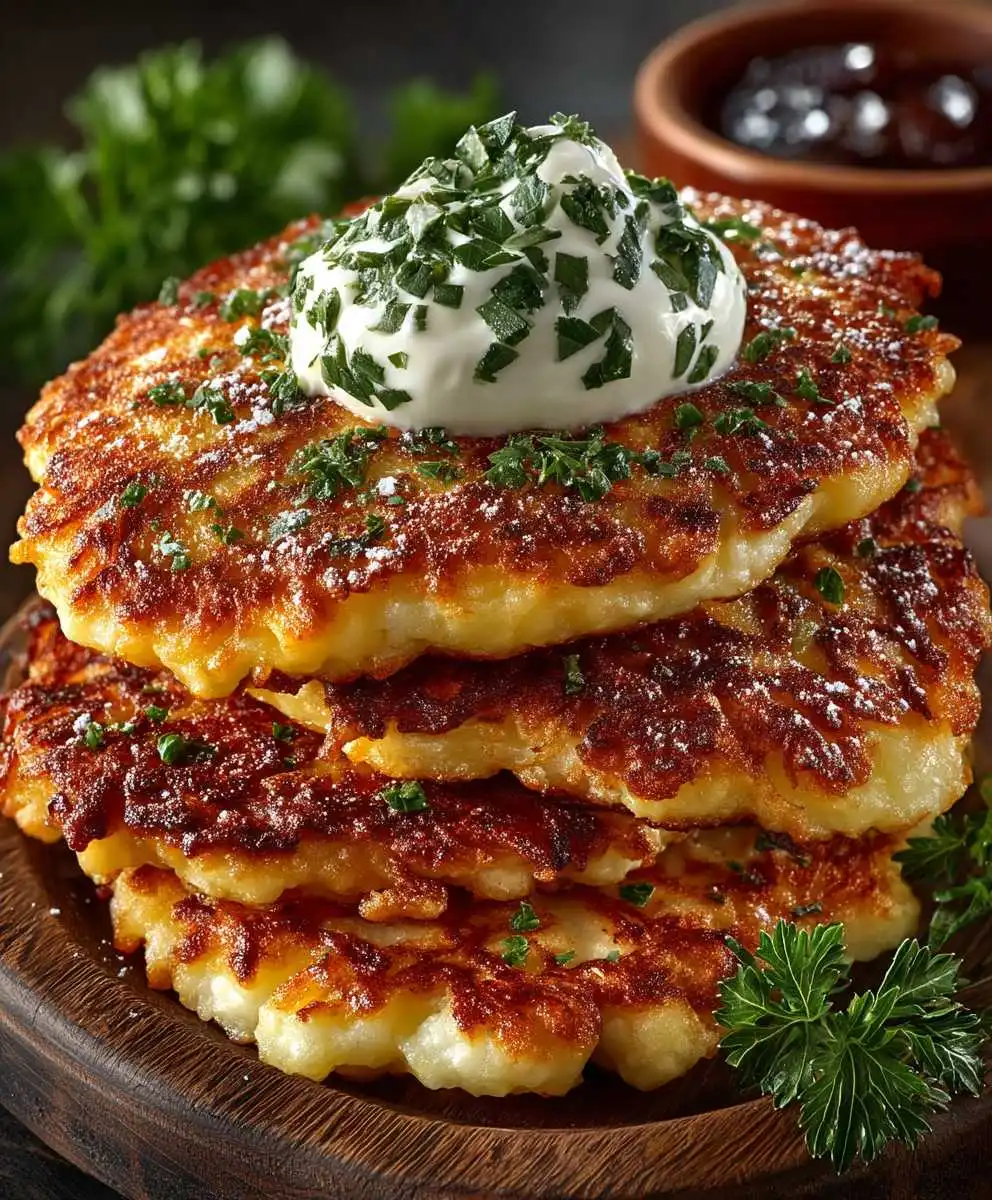
Conclusion:
This isn’t just another potato pancake recipe; it’s a journey to the heart of German comfort food, a crispy, golden invitation to a world of flavor. These German Potato Pancakes, or Kartoffelpuffer as they’re lovingly known, are more than just a side dish; they’re a star in their own right. The perfect balance of savory potato, subtle onion, and that irresistible crispy exterior makes them utterly addictive. I truly believe this recipe is a must-try for anyone looking to expand their culinary horizons or simply seeking a comforting and delicious meal.
But why is this particular recipe so special? It’s all about the technique. We’ve meticulously crafted each step to ensure you achieve that perfect balance of crispy edges and a tender, flavorful interior. From properly draining the potatoes to using the right amount of binding agent, every detail has been considered to guarantee success, even for novice cooks. Plus, the simple ingredients mean you likely already have most of what you need in your pantry!
Now, let’s talk serving suggestions. While these German Potato Pancakes are fantastic on their own, they truly shine when paired with complementary flavors. For a traditional German experience, serve them with applesauce and a dollop of sour cream. The sweetness of the applesauce beautifully contrasts with the savory pancakes, creating a delightful harmony on your palate. Alternatively, you can go the savory route and serve them with smoked salmon and a sprinkle of fresh dill. The smoky fish adds a layer of richness that elevates the entire dish.
And don’t be afraid to experiment! This recipe is incredibly versatile. For a spicier kick, add a pinch of cayenne pepper to the batter. If you’re feeling adventurous, try incorporating different herbs and spices, such as chives, parsley, or even a touch of nutmeg. You could also experiment with different toppings. Think crispy bacon crumbles, caramelized onions, or even a fried egg for a truly decadent breakfast or brunch.
Variations to Explore:
* Sweet Potato Pancakes: Substitute half of the potatoes with sweet potatoes for a sweeter, more vibrant flavor.
* Zucchini Potato Pancakes: Add grated zucchini to the batter for a lighter, more refreshing twist.
* Herbed Potato Pancakes: Incorporate a mix of fresh herbs, such as rosemary, thyme, and sage, for a more aromatic and flavorful pancake.
* Vegan Potato Pancakes: Substitute the egg with a flax egg (1 tablespoon of ground flaxseed mixed with 3 tablespoons of water) and ensure your oil is plant-based.I’m so excited for you to try this recipe and experience the joy of homemade German Potato Pancakes. I’ve poured my heart into perfecting this recipe, and I’m confident that you’ll love it as much as I do. Don’t be intimidated by the process; it’s much simpler than it looks. Just follow the instructions carefully, and you’ll be rewarded with a plate of golden, crispy goodness.
So, what are you waiting for? Gather your ingredients, put on some music, and get ready to embark on a culinary adventure. I can’t wait to hear about your experience! Please, share your photos and comments with me. Let me know what variations you tried, what toppings you loved, and any tips you have for making these pancakes even more amazing. Your feedback is invaluable, and it helps me continue to improve and share delicious recipes with the world. Happy cooking, and Guten Appetit!
German Potato Pancakes: The Ultimate Recipe and Guide
Crispy, golden German potato pancakes (Kartoffelpuffer) with grated potatoes, onion, and nutmeg. Serve with applesauce or sour cream!
Ingredients
- 2 lbs Potatoes (Russet or Yukon Gold, peeled)
- 1 medium Onion (finely grated or minced)
- 2 large Eggs
- ½ cup All-Purpose Flour (plus more for dusting)
- ½ teaspoon Baking Powder
- 1 ½ teaspoons Salt (or to taste)
- ¼ teaspoon Black Pepper (or to taste)
- Pinch Nutmeg (optional, but recommended)
- Vegetable Oil or Lard (for frying)
- Applesauce or Sour Cream (for serving, optional)
Instructions
- Grate the Potatoes: Use a box grater with large holes or a food processor with a grating attachment to coarsely grate the potatoes.
- Drain the Potatoes: Place the grated potatoes in a clean kitchen towel or cheesecloth. Gather the edges and squeeze firmly to extract as much liquid as possible. Repeat. Alternatively, press down firmly with a spoon in a colander.
- Combine Ingredients: In a large bowl, combine the drained grated potatoes, grated onion, eggs, flour, baking powder, salt, pepper, and nutmeg (if using). Mix well until evenly distributed. Don’t overmix. If the mixture seems too wet, add flour, a tablespoon at a time, until the desired consistency is reached.
- Heat the Oil: Place a large skillet (cast iron is ideal) over medium-high heat. Add enough vegetable oil or lard to coat the bottom of the skillet, about ¼ inch deep. The oil should be hot enough that a small piece of potato mixture sizzles immediately when dropped in.
- Form the Pancakes: For each pancake, scoop about ¼ cup of the potato mixture into the hot oil. Gently flatten the mixture with the back of a spoon to form a pancake about ½ inch thick. Be careful not to overcrowd the skillet; cook in batches to avoid lowering the oil temperature too much.
- Fry the Pancakes: Fry the pancakes for about 3-4 minutes per side, or until they are golden brown and crispy. Use a spatula to carefully flip the pancakes. If they are browning too quickly, reduce the heat slightly.
- Drain the Pancakes: Once the pancakes are cooked through, remove them from the skillet and place them on a wire rack lined with paper towels to drain excess oil.
- Serve Immediately: Serve hot and fresh with applesauce, sour cream, chives, bacon, onion dip, or gravy.
Notes
- Potato Choice: Russet or Yukon Gold potatoes are preferred. Russets have higher starch content, which helps them bind together better and get crispier. Yukon Golds have a slightly creamier texture and a more subtle flavor.
- Draining is Key: Removing excess moisture from the grated potatoes is essential for crispy pancakes.
- Grate Onion Finely: Grating the onion finely ensures that it cooks evenly and doesn’t overpower the flavor of the pancakes.
- Adjust Flour: The amount of flour you need may vary depending on the moisture content of your potatoes. Start with ½ cup and add more, a tablespoon at a time, until you reach the desired consistency. The mixture should be slightly wet but not watery.
- Don’t Overcrowd: Cooking the pancakes in batches prevents the oil temperature from dropping too much, which can result in greasy pancakes.
- Keep Warm: If you’re making a large batch of pancakes, you can keep them warm in a preheated oven (200°F) while you finish cooking the rest. Place the cooked pancakes on a wire rack in a single layer to prevent them from getting soggy.
- Experiment: Feel free to experiment with different flavors and seasonings. You can add garlic powder, onion powder, paprika, or other spices to the potato mixture. You can also add chopped herbs, such as parsley or chives.
- Make Ahead: You can prepare the potato mixture ahead of time and store it in the refrigerator for up to 24 hours. However, keep in mind that the potatoes may release more moisture as they sit, so you may need to drain them again before frying.
- Freezing: Cooked potato pancakes can be frozen for later use. Let them cool completely, then place them in a single layer on a baking sheet and freeze for about 30 minutes. Once they’re frozen solid, transfer them to a freezer bag or container. To reheat, bake them in a preheated oven (350°F) for about 10-15 minutes, or until heated through and crispy.
- Troubleshooting:
- Soggy Pancakes: Drain potatoes properly and add more flour.
- Burning Outside, Raw Inside: Reduce heat.
- Falling Apart: Add more flour or an extra egg.
- Sticking to Skillet: Ensure skillet is properly heated and use enough oil.
- Variations:
- Sweet Potato Pancakes: Substitute sweet potatoes for the regular potatoes.
- Zucchini Pancakes: Add grated zucchini to the potato mixture.
- Apple Pancakes: Add grated apple to the potato mixture.
- Herbed Pancakes: Add chopped fresh herbs, such as parsley, chives, or dill, to the potato mixture.
- Spicy Pancakes: Add a pinch of cayenne pepper or a dash of hot sauce to the potato mixture.
- Serving Suggestions Beyond the Basics:
- With Smoked Salmon and Cream Cheese: A sophisticated twist! Top the potato pancakes with smoked salmon, cream cheese, and a sprinkle of dill.
- As a Base for Eggs Benedict: Use the potato pancakes instead of English muffins for a unique and delicious Eggs Benedict

